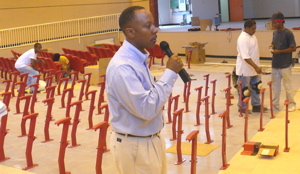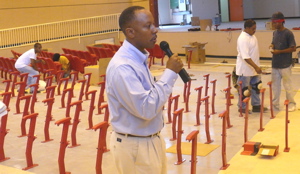

Commissioner Darryl Smalls and his top lieutenants took reporters around St. Croix Thursday, touring some of the major ongoing and soon-to-start projects, one being the Scenic Road.
"We have funding for approximately 6,000 feet of pavement," Smalls said. About $2 million is allotted for drainage work, paving and striping of that first section. While it’s good the work will begin, the Scenic Road will be done in many phases, as money becomes available, he said.
"The entire road is nearly 16 miles, and the going rate for paving a road is in the neighborhood of $1 million per mile – and it can exceed that," he said. "If we do the math, we are talking about a very substantial project. We will complete it all the way west to Frederiksted, but it will be in phases."
Over in Williams Delight, $6 million has been secured and a contractor selected for long-awaited paving work in the large west-end St. Croix neighborhood. Major drainage work had to be completed before road work could begin, but that work is now done and the road work has gone out to bid, said Assistant Commissioner of Public Works Roberto Cintron.
"The neighborhood lies on a flood plain and heavy rains pool in the roads" Cintron said. "Our challenge was to channel all the water flow into the eastern and western guts."
The southwest quadrant of Williams Delight, delineated by Main Street, Church Street and the Melvin Evans Highway, will be paved in this round of work, he said.
When complete, the road work will bring relief to the residents of William’s Delight, who for years have dealt with flooding, badly rutted, partially paved and unpaved roads and the incomplete remains of earlier work to install large box culverts to capture and divert rainwater.
Work on the first phase of the Christiansted Bypass is complete and bids on the second phase are being considered right now, said Cintron.
"Contrary to what you may have heard, work on the bypass is not at a standstill," said Cintron.
John Paul David, federal highway programs manager at Public Works, said the bypass should be complete and ready for driving in about two years, with the current, second phase taking almost one year and the final phase a second year. It will take about $12 million more to finish it, with $7 million budgeted for the second phase, Smalls said.
At John H. Woodson Jr. High, Public Works contractors are busily installing more than 50 air conditioning units, upgrading the wiring, installing a new ceiling, new seating and new flooring in the school’s auditorium. Thieves stole some expensive copper cable and vandalized the electrical work last week, but work is continuing at a good pace nonetheless, Smalls said.
"We are comfortable when the students arrive we will be ready," he said.
These are only some of the major ongoing and soon-to-start projects on St. Croix. Major work on the Queen Mary Highway will begin next year, major drainage and paving work begun recently in Estate Little LaGrange is nearly complete, bids have gone out for repairs to the road to Point Udall and bus shelters throughout the territory are getting a facelift, among other projects under way or in planning.
Even without the bond and the stimulus funding, there is more territorial road funding than any time in the recent past, Smalls said. And while there is more funding than usual right now, spending it quickly and efficiently while beginning many new projects in a short frame of time creates its own interesting challenges.
"Throughout the U.S., states right now are asking contractors, who for many months before have not been working much, to really ramp up their operations," Smalls said.
The contractors are eager to get the work, but have to consider what will be happening two or three years down the road as they make their hiring and capital decisions, he said. For instance, a contractor has to decide whether to buy new heavy equipment to speed up work on roads right now, and weigh whether road funding is going to dry up a year or two in the future, and the very expensive machines left idle, he said.
Over the long run, Smalls wants to see a steady, predictable pace of road work, keeping the roads better maintained and giving road contractors a predictable, relatively steady amount of work.
Meanwhile, a lot of work will be done throughout the territory over the next two years.